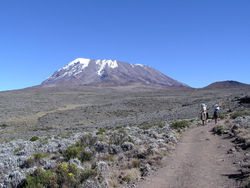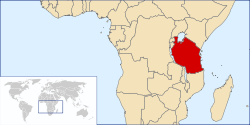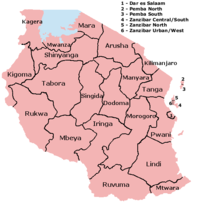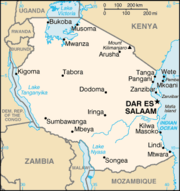Tanzania
2008/9 Schools Wikipedia Selection. Related subjects: Africa; African Countries
| Jamhuri ya Muungano wa Tanzania United Republic of Tanzania
|
||||||
|---|---|---|---|---|---|---|
|
||||||
| Motto: "Uhuru na Umoja" ( Swahili) "Freedom and Unity" |
||||||
| Anthem: Mungu ibariki Afrika "God Bless Africa" |
||||||
|
|
||||||
| Capital | Dodoma | |||||
| Largest city | Dar es Salaam | |||||
| Official languages | Swahili (de facto) | |||||
| Demonym | Tanzanian | |||||
| Government | Republic | |||||
| - | President | Jakaya Mrisho Kikwete | ||||
| - | Prime Minister | Mizengo Pinda | ||||
| Independence | from the United Kingdom | |||||
| - | Tanganyika | December 9, 1961 | ||||
| - | Zanzibar | December 10, 1963 | ||||
| - | Merger | April 26, 1964 | ||||
| Area | ||||||
| - | Total | 945,087 km² ( 31st) 364,898 sq mi |
||||
| - | Water (%) | 6.2 | ||||
| Population | ||||||
| - | November 2006 estimate | 37,849,1331 ( 32nd) | ||||
| - | 2002 census | 35,214,888 | ||||
| - | Density | 41/km² ( 159th) 106/sq mi |
||||
| GDP ( PPP) | 2007 estimate | |||||
| - | Total | $27.12 billion ( 99th) | ||||
| - | Per capita | $1,100 ( 178th) | ||||
| Gini (2000–01) | 34.6 (medium capital = Dar es Salaam) | |||||
| HDI (2005) | ▲ 0.467 (low) ( 159th) | |||||
| Currency | Tanzanian shilling ( TZS) |
|||||
| Time zone | EAT ( UTC+3) | |||||
| - | Summer ( DST) | not observed ( UTC+3) | ||||
| Internet TLD | .tz | |||||
| Calling code | +255² | |||||
| 1 Estimates for this country explicitly take into account the effects of excess mortality due to AIDS; this can result in lower life expectancy, higher infant mortality and death rates, lower population and growth rates, and changes in the distribution of population by age and sex than would otherwise be expected. ² 007 from Kenya and Uganda. |
||||||
Tanzania IPA: /ˌtænzəˈniːə/, officially the United Republic of Tanzania ( Swahili: Jamhuri ya Muungano wa Tanzania), is a country in East Africa bordered by Kenya and Uganda on the north, Rwanda, Burundi and the Democratic Republic of the Congo on the west, and Zambia, Malawi and Mozambique on the south. To the east it borders the Indian Ocean.
The country's name is a portmanteau of Tanganyika, the large mainland territory, and Zanzibar, the offshore archipelago. The two former British colonies united in 1964, forming the United Republic of Tanganyika and Zanzibar, which later the same year was renamed the United Republic of Tanzania.
In 1996 government offices were transferred from Dar es Salaam to Dodoma, making Dodoma the country's political capital. Dar es Salaam remains the principal commercial city.
History
What is now Tanzania was a colony and part of Germany from the 1880s to 1919. Under the League of Nations, the area became a British Mandate from 1919 to 1961. It served as a military outpost during World War II and provided financial help as well as munitions. Julius Nyerere became Minister of British-administered Tanganyika in 1960 and continued as Prime Minister when Tanganyika became independent in 1961. Tanganyika and neighbouring Zanzibar, which had become independent in 1963, merged to form the nation of Tanzania on April 26, 1964. One-party rule came to an end in 1995 with the first democratic elections held in the country since the 1970s. Having been essentially a socialist state soon after independence, Tanzanian economic aid went hand in hand with structural adjustment conditionalities that deteriorated the nation's economy. This deterioration was due to a sudden shift to capitalism when the societal and economic framework of the nation was a socialist one. During the 80s Tanzanian GDP growth increased (due to SAPs) yet Human Development Indexes lowered. Tanzania still struggles with economic development yet its outlook is positive due to increasing natural resource exports.
Politics
Tanzania's president and National Assembly members are elected concurrently by direct popular vote for five-year terms. The president appoints a prime minister who serves as the government's leader in the National Assembly. The president selects his cabinet from among National Assembly members. The Constitution also empowers him to nominate ten non-elected members of Parliament, who also are eligible to become cabinet members. Elections for president and all National Assembly seats were held in December 2005.
The unicameral National Assembly elected in 2000 has 295 members. These 295 members include the Attorney General, five members elected from the Zanzibar House of Representatives to participate in the Parliament, the special women's seats which are made up of 20% of the seats a particular party has in the House, 181 constituents seats of members of Parliament from the mainland, and 50 seats from Zanzibar. Also in the list are forty-eight appointed for women and the seats for the 10 nominated members of Parliament. At present, the ruling CCM holds about 93% of the seats in the Assembly. Laws passed by the National Assembly are valid for Zanzibar only in specifically designated union matters.
Zanzibar's House of Representatives has jurisdiction over all non-union matters. There are currently seventy-six members in the House of Representatives in Zanzibar, including fifty elected by the people, ten appointed by the president of Zanzibar, five ex officio members, and an attorney general appointed by the president. In May 2002, the government increased the number of special seats allocated to women from ten to fifteen, which will increase the number of House of Representatives members to eighty-one. Ostensibly, Zanzibar's House of Representatives can make laws for Zanzibar without the approval of the union government as long as it does not involve union-designated matters. The terms of office for Zanzibar's president and House of Representatives also are five years. The semiautonomous relationship between Zanzibar and the union is a relatively unusual system of government.
Tanzania has a five-level judiciary combining the jurisdictions of tribal, Islamic, and British common law. Appeal is from the primary courts through the district courts, resident magistrate courts, to the high courts, and Court of Appeals. Judges are appointed by the Chief Justice, except those for the Court of Appeals and the High Court who are appointed by the president. The Zanzibari court system parallels the legal system of the union, and all cases tried in Zanzibari courts, except for those involving constitutional issues and Islamic law, can be appealed to the Court of Appeals of the union. A commercial court was established in September 1999 as a division of the High Court.
Regions and districts
Tanzania is divided into 26 regions (mkoa), twenty-one on the mainland and five on Zanzibar (three on Unguja, two on Pemba). Ninety-eight districts (wilaya), each with at least one council, have been created to further increase local authority; the councils are also known as local government authorities. Currently there are 114 councils operating in 99 districts; 22 are urban and 92 are rural. The 22 urban units are further classified as city councils (Dar es Salaam and Mwanza), municipal councils (Arusha, Dodoma, Iringa, Kilimanjaro, Mbeya, Morogoro, Shinyanga, Tabora, and Tanga) or town councils (the remaining eleven communities).
Tanzania's regions are: Arusha · Dar es Salaam · Dodoma · Iringa · Kagera · Kigoma · Kilimanjaro · Lindi · Manyara · Mara · Mbeya · Morogoro · Mtwara · Mwanza · Pemba North · Pemba South · Pwani · Rukwa · Ruvuma · Shinyanga · Singida · Tabora · Tanga · Zanzibar Central/South · Zanzibar North · Zanzibar Urban/West
For regions ranked by total area, land area and water area, see List of Tanzanian regions by area.
Geography
At 364,875 mi² (945,087 km²), Tanzania is the world's 31st-largest country (it comes after Egypt). It is comparable in size to Nigeria, and is slightly more than twice the size of the U.S. state of California.
Tanzania is mountainous in the north-east, where Mount Kilimanjaro * , Africa's highest peak, is situated. To the north and west are the Great Lakes of Lake Victoria (Africa's largest lake) and Lake Tanganyika (Africa's deepest lake, known for its unique species of fish). Central Tanzania comprises a large plateau, with plains and arable land. The eastern shore is hot and humid, with the island of Zanzibar lying just offshore.
Tanzania contains many large and ecologically significant wildlife parks * , including the famous Ngorongoro Crater, Serengeti National Park* in the north, and Selous Game Reserve and Mikumi National Park in the south. Gombe National Park in the west is known as the site of Dr. Jane Goodall's studies of chimpanzee behaviour.
The government of Tanzania through its department of tourism has embarked on a campaign to promote the Kalambo water falls in south-west Tanzania's region of Rukwa as one of Tanzania's many tourist destinations * * . The Kalambo falls are the second largest in Africa and are located near the southern tip of Lake Tanganyika.
Environment

Tanzania has considerable land area of wildlife habitat, including much of the Serengeti plain, where the white-bearded wildebeest (Connochaetes taurinus mearnsi) and other bovids participate in a large scale annual migration. Up to 250,000 wildebeest perish each year in the long and arduous movement to find forage in the dry season. Tanzania is also home to 130 amphibian and over 275 reptile species, many of them strictly endemic and included in the IUCN Red lists of different countries. Tanzania has developed a Biodiversity Action Plan to address species conservation.
Economy
The economy is mostly based on agriculture, which accounts for more than half of GDP, provides 85% (approximately) of exports, and employs 80% (approximately) of the workforce. Topography and climatic conditions, however, limit cultivated crops to only 4% of the land area. Industry is mainly limited to processing agricultural products and light consumer goods. Tanzania has vast amounts of natural resources including gold deposits and diamonds. Tanzania is also known for the Tanzanite gemstones. Tanzania has dozens of beautiful national parks like the world famous Serengeti and the Ngorongoro Conservation Area, that generate income with a large tourism sector that plays a vital part in the economy. Growth from 1991 to 1999 featured a pickup in industrial production and a substantial increase in output of minerals, led by gold. Commercial production of natural gas from the Songo Songo island in the Indian Ocean off the Rufiji Delta commenced 2004, with natural gas being pumped in a pipeline to the commercial capital Dar es Salaam, with the bulk of it being converted to electricity by the public utility and private operators. A new gas field is being brought on stream in Mnazi Bay.
Recent public sector and banking reforms, and revamped and new legislative frameworks have all helped increase private sector growth and investment. Short-term economic progress also depends on curbing corruption and cutting back on unnecessary public spending.
Prolonged drought during the early years of the 21st century has severely reduced electricity generation capacity (some 60% of Tanzania's electricity supplies are generated by hydro-electric schemes). During 2006 Tanzania suffered a crippling series of "load-shedding" or power rationing because of the shortfall of generated power, largely because of insufficient hydro-electric generation. Plans to increase gas and coal fueled generation capacity are likely to take some years to implement, and growth is forecast to be increased to seven per cent per year, and perhaps eight or more.
There are 3 major airlines in Tanzania, the Air Tanzania Corporation, the PrecisionAir which do local flights - Arusha, Kigoma, Mtwara, Mwanza, Musoma, Shinyanga, Zanzibar) and regional flights to Kigali,Nairobi, Mombasa routes and the third one that does local flights only. There are also several charter aeroplane firms. There are two railway companies: TAZARA caters for service between Dar-es-Salaam and Kapiri-Mposhi, a district of the Central Province in Zambia. The other one is the Tanzania Railways Corporation, which provides services between Dar-es-Salaam and Kigoma, a town on the shores of Lake Tanganyika and between Dar-es-Salaam and Mwanza, a city on the shores of lake Victoria. There is also a service across the Indian Ocean between Dar-es-Salaam and Zanzibar by several modern hydrofoil boats.
Demographics
As of 2006, the estimated population is 38,329,000, with an estimated growth rate of 2%. Population distribution is extremely uneven, with density varying from 1 person per square kilometer (3/mi²) in arid regions to 51 per square kilometer (133/mi²) in the mainland's well-watered highlands, to 134 per square kilometer (347/mi²) on Zanzibar. More than 80% of the population is rural. Tanzania still has a very high unemployment rate,which is about 67%. Dar es Salaam is the largest city and is the commercial capital; Dodoma, located in the centre of Tanzania is the new capital and houses the Union's Parliament. Zanzibar Town houses the Zanzibar Parliament.
The African population consists of more than 126 ethnic groups, of which the Sukuma and Nyamwezi, the Hehe and Bena, the Gogo, the Haya, the Makonde, the Chagga and the Nyakyusa have more than 1 million members. Other groups include the Pare, Sambaa or Shambala and Ngoni. The majority of Tanzanians, including such large ethnic groups as the Sukuma and the Nyamwezi, have Bantu origins. Groups of Nilotic or related origin include the nomadic Masai and the Luo, both of which are found in greater numbers in neighboring Kenya. Two small groups speak languages of the Khoisan family peculiar to the people of the Kalahari in southern Africa. Cushitic-speaking peoples, originally from the Ethiopian highlands, reside in a few areas of Tanzania. Other Bantu groups were refugees and immigrants from nearby countries.
Although much of Zanzibar's African population came from the mainland, one group known as Afro-Shirazis claims its origins to be the island's early Persian settlers. Non-Africans residing on the mainland and Zanzibar account for 1% of the total population. In the 1960s and 1970s thousands of Asians emigrated, frequently under duress. Often they attempted to emigrate to the United Kingdom , and now the UK is home to 100,000 Tanzanians making the Tanzanian British community the world's largest overseas Tanzanian community. Their community, including Hindus, Sunni Muslims, Sikhs, Parsis and Goans, has increased in the past decade to 350,000. An estimated 240,000 Arabs and 70,000 Europeans still reside in Tanzania.
Languages
Tanzania has more than 126 tribes and each ethnic group has its own language. No language is de jure official, but Swahili is the de facto official national language, used for inter-ethnic communication and for official matters. After gaining independence, English, the language of colonial administration during the era of British rule, was still used for some official issues, and was thus considered de facto official alongside Swahili. As official usage of English has greatly diminished during the first thirty years following independence, and it was more common to regard Swahili as the only de facto official language. However the political reforms which turned Tanzania away from a closed and socialist environment and a centrally planned economy inevitably resulted in a dramatic opening up of the country. The attendant growth of the private sector and new investment has resulted in English having increasing importance, and there are many schools in which English is the medium of instruction. Universities all use English as the medium of instruction, which often causes problems for students who have previously only taken English as a subject in school. Other spoken languages are Indian languages, especially Gujarati, and Portuguese (both spoken by Mozambican blacks and Goans). Historically German was widely spoken during that colonial period, but few remain alive who remember that period.
Culture
The music of Tanzania stretches from traditional African music to the string-based taarab to a distinctive hip hop known as bongo flava. Famous taarab singers names are Abbasi Mzee, Culture Musical Club, Shakila of Black Star Musical Group. Internationally known traditional artist are Bi Kidude, Hukwe Zawose and Tatu Nane.
Tanzania has its own distinct African rumba music where names of artists/groups like [[Tabora Jazz, Western Jazz Band, Morogoro Jazz, Volcano Jazz, Simba Wanyika, Remmy Ongala, Ndala Kasheba * , NUTA JAZZ, ATOMIC JAZZ, DDC Mlimani Park, Afro 70 & Patrick Balisidya* * * , Sunburst, Tatu Nane * and Orchestra Makassy* must be mentioned in the history of Tanzanian music.
Tanzania has many writers. The list of writers' names includes well known writers such as Godfrey Mwakikagile, Mohamed Said, Prof. Joseph Mbele* , Juma Volter Mwapachu, Prof. Issa Shivji, Jenerali Twaha Ulimwengu, Prof.Penina Mlama* , Mwalimu Julius Kambarage Nyerere, Adam Shafi, Dr. Malima M.P Bundala and Shaaban Robert.




